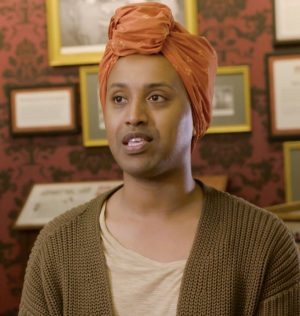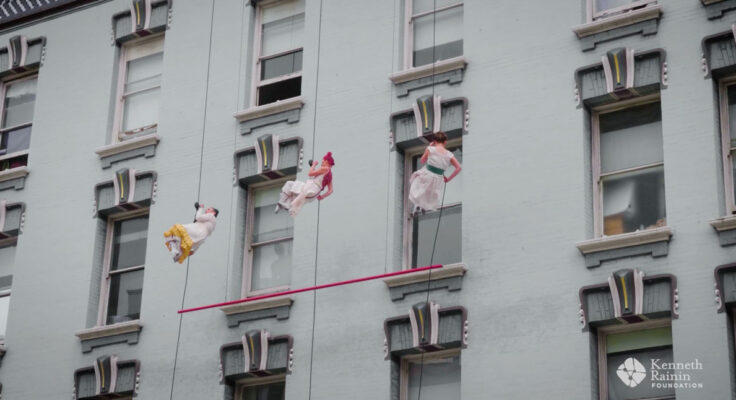As we reflect on a year filled with social justice uprisings, the project featured in the above video and the legacies it elevates feel profoundly relevant. This site-specific dance, TENDER (n) a person who takes charge, took place at the Cadillac Hotel and celebrated 100 years of activism in San Francisco’s Tenderloin. The work was grounded in multiple stories about justice—the culture of liberation among working women in the early 20th century, 1960s transgender activism, and the role that Vietnamese immigrants and the Hotel continue to play in shaping the neighborhood.
This project, featured in the video below, used temporary public art to elevate underrepresented histories. It also engaged the community in celebrating the residents who continue to seek a desirable place to live and thrive while facing gentrification and rising inequality.
With this temporary art project now completed, we wondered about its lasting imprint. We invited one of the performers, Honey Mahogany, who is also a community activist and co-founder of the Transgender District, to write about her experience.
Reflections by Honey Mahogany
I find myself reflecting on my experience performing as a part of TENDER quite often. At the time, my work as a performer was beginning to take a backseat to my work in advocacy and politics, which was quickly taking over my life. When I was approached to be a part of the show, I was thrilled by the opportunity to have what felt like one last big hurrah in the spotlight before throwing myself fully into the clutches of city government.

As we began rehearsals for TENDER, it soon became clear that the show highlighted many of the things I love most about San Francisco: diversity, art, community, and self-discovery. It also seemed to bring together important, persistent themes from my life in a way that I didn’t quite expect. Beyond the death-defying aerial choreography and period costumes was an underlying sense of urgency—a gravitas to the stories being spun through choreography, music, and narrative recordings.
Even though TENDER is a historical reflection of life in the Tenderloin, it is evident that this is a living history. Many of the characters and stories that were portrayed throughout the piece found echoes in the people that surrounded us and watched us dance on fire escapes and rooftops from the ground below.
One of my favorite parts of my participation in TENDER was getting to know the residents who lived in the Cadillac Hotel, getting to speak with them in between rehearsals, or chatting with them while waiting in the hallway for an entrance cue. Most of them were thrilled by the excitement of the show, and getting to feel a part of something that was artistic and beautiful and poignant. However, I do remember one resident who was not as thrilled. In fact, there was an incident where I was locked out on the balcony during one rehearsal by this person who was, I was told, just generally really grumpy. And I couldn’t blame him. I was in his space, interrupting his routine. But, the other residents reassured me that I shouldn’t take it personally, and one promised to keep an eye out in case it happened again. For me, these interactions with the residents of the Cadillac Hotel made the stories we were telling through dance all the more tangible and relevant.
As a co-founder of the Transgender District, TENDER really struck a nerve. The Transgender District is an officially sanctioned part of the city encompassing a few blocks in the Tenderloin that pays homage to the legacy of queer and trans liberation tracing back to the Compton’s Cafeteria Riots of 1966. An important part of the district’s work is to preserve the living history of the area, the cultural assets that are still here, building upon those assets to create a future where these places, institutions, and people can flourish.
The stories we told through TENDER aren’t just stories, but living, breathing communities. I know that the Tenderloin has a reputation for being a troubled place, and in truth it is a neighborhood afflicted by vicious cycles of poverty and systemic racism on one side and rising inequality and rapid gentrification on the other, but it is also a place that is incredibly kind and beautiful. The Tenderloin is a neighborhood, forged by resilience and persistence, that contains a vital part of our collective narrative. Perhaps with places like the Transgender District cropping up, the Tenderloin can provide us with a template for the future; a positive model that does not displace or exclude, but strengthens, restores, and celebrates all of our diverse communities.
Community Responsive Collaboration
TENDER was led by Jo Kreiter’s Flyaway Productions, Vân-Ánh Võ, Sean Riley, and the Tenderloin Museum in collaboration with the Asian Art Museum, Au Co Center, Cadillac Hotel, Code Tenderloin and CounterPulse. TENDER was awarded a grant through the Kenneth Rainin Foundation’s Open Spaces Program. This grantmaking program supports temporary public art projects that build community and highlight diverse and underrepresented voices.
TENDER also focused on hiring and empowering people from the community. The event team was comprised of Code Tenderloin participants who received intensive training and references to help them pursue future work. GIRLFLY, a dance and activism apprenticeship program of Flyaway Productions, hired 20 teenage girls to conduct oral histories of current day activists. These stories were translated into performances at CounterPulse and designed as posters for an exhibition at the Tenderloin Museum. We invite you to watch the above video and see this spectacular work.

